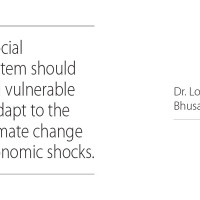- Thursday, 18 April 2024
Go Deeper For Suicide Prevention
Nishtha Shrestha
In September, there has been an avalanche of talks and workshops on suicide prevention. This level of widespread awareness is warranted considering the rise in the rate of suicide. As per police records, the rate of suicide has risen by 14.2 per cent in the current year. It is no longer an issue we can attribute to a whim of a person and shy away from taking responsibility. The programmes on suicide prevention focus on the probable causes, symptoms and ways to help the person. But we must shift our focus from the individual and explore the deeper factors behind suicide which have not received our attention.
Suicide is usually the last step taken by the individual. When the coping resources have failed, the lack of hope and belief for a better outcome drives the individual to take this extreme step. We are scared to talk about suicide as we are not aware of how to help a person if we come to know about it. Sometimes we choose to live in denial that our close ones might have suicidal tendencies. The fear of a label, lack of support system and limited avenues to seek help further add to the existing stress of the affected person. These barriers to help-seeking are common knowledge. As a society, what we must now do is eliminate the creation of these obstacles rather than trying to manage their impacts.
The main problem in current suicide prevention is the surface-level efforts to address suicide. Researchers have specified stress as a causal factor but we have not made any attempts to dig deeper. The first lesson to handle stress is learnt in childhood. Children observe and adopt the techniques used by their parents. Thus, it is up to the parents to model healthy ways to express and manage emotions. All the emotions are necessary for our survival and this includes even anger, sadness and jealousy which are discouraged in society. A child who is punished for being angry or sad will learn to hide this emotion as an adult. Parents need to attempt to find the actual cause behind the emotion instead of resorting to punishment immediately.
Another important aspect of suicide prevention is the creation of a safe environment. When the children feel safe, they learn to be their true self. When they reach adolescence, they are more open to reaching out to parents whenever they are in trouble. Without fear of judgement, they seek support and this helps to tackle the problem before it escalates. As we grow older, the pressures of adulthood reduce our interactions with society. Isolation is another area we need to tackle to prevent suicide. Healthy social connections result in strong social support which is a protective factor. Therefore, building and sustaining social relationships is a life skill we need to teach in society.
In Nepal, there is a limited fund for mental health and the preferred mode of treatment is medication. While medicines are important, these three factors which are freedom to express emotions, a safe environment and strong social relationships need to be promoted for better mental health. There is a need for suicide awareness but if we can create these basic factors for everyone then we can prevent people from thinking that suicide is an option to end their suffering.















